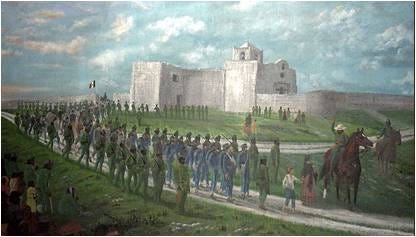On this Day in History, A Symbol of Texan Identity
The massacre at Goliad unites Texas against Mexico
On this day in 1836, 300 Texian soldiers were executed on the orders of Mexican General Antonio López de Santa Anna. The event was a turning point in the Texas Revolution, and immortalized in the battle cry heard at San Jacinto one month later: “Remember the Alamo! Remember Goliad!”

The Battle of Goliad was not a single battle but a series of events that led to the mass execution of Texian soldiers by the Mexican Army.
The Battle of Gonzales — On October 2, 1835, Texian rebels fought against Mexican soldiers in the Battle of Gonzales, about 60 miles east of San Antonio. The Texians won the battle, which is considered the first battle of the Texas Revolution.
Siege of San Antonio — After the Battle of Gonzales, Texian forces marched to San Antonio, which was occupied by Mexican troops. The Texans laid siege to the city for two months, and on December 10, 1835, they successfully captured it. They garrisoned the Alamo, which ultimately became a death trap during the Battle of the Alamo months later.
Battle of Refugio — In early 1836, Mexican troops under the command of General Jose Urrea invaded Texas from the south. On March 14, 1836, they attacked a group of Texian soldiers at Refugio, just north of the Nueces river, which would later become part of a border dispute between the United States and Mexico. After a two-day battle, the Texians surrendered.
Battle of Coleto Creek — After the Texians surrendered at Refugio, they were marched north to Goliad, where they were held as prisoners of war. On March 19, 1836, Texian Colonel James Fannin and his troops were attacked by Mexican forces at Coleto Creek just east of Goliad. After a two-day battle, Fannin surrendered to General Urrea.
After Fannin surrendered, he and his men were held at Goliad under the belief that they would be treated as prisoners of war. However, on March 27, 1836, Mexican General Antonio López de Santa Anna ordered the execution of over 300 Texian soldiers at Goliad. This brutal event, known as the Goliad Massacre, was a turning point in the Texas Revolution and fueled the Texians’ determination to win independence from Mexico.
This battle, and the Texas Revolution itself, were not isolated events. They were theaters in an ongoing, decades-long struggle during what is known as the Age of Santa Anna in Mexico. The general started his career as a military officer at the head of the military garrison at Veracruz during the Mexican War of Independence. During the first Mexican Empire, he rose to power helping lead a rebellion that led to the first Mexican Republic in 1824.
He then led the resistance against a Spanish attempt to reconquer Mexico, becoming a national hero. Eventually, he entered politics and rose to power as part of the Federalists, who supported a decentralized form of government, as opposed to the Centralists, who wanted to concentrate power in the federal government. Eventually, he would share power as president with progressive Valentin Farias beginning in 1833.
After a series of coup attempts and an unpopular anti-clerical campaign by Farias, Santa Anna betrayed Farias and removed him from power, revoked the constitution, and dissolved the congress. He instituted a temporary constitution and allowed Congress to reconvene with the object of drafting a new constitution. In 1835, a new Centralist constitution was promulgated.
In response to a unilateral suspension of the Mexican constitution and the institution of one that centralized power in the president and the federal government, multiple states, including Texas, rebelled. The response of Santa Anna was to personally lead armies to crush the rebellions. In the north, rebellions were suppressed in California, New Mexico, and Zacatecas. Yucatan and Tabasco in the South were also subdued using military blockades.
Only the Texas Revolution would end up being successful. Unique among the other states, it had a large population of settlers from America with the resources that entailed, including covert American support. Texas was therefore the most isolated from the government in Mexico City and the least likely to respond well to attempts to subdue it. Santa Anna’s decision to use unnecessary acts of cruelty, such as the Goliad Massacre, to break the will of the Texians failed.
It helped unite the fledgling country with a common enemy and gave them symbols around which to forge a national identity. This history has repeated itself many times, such as with the ancient Greeks against Persia, the French against the English, and, in modern times, the Ukrainians against Russia. Rebellions rise, governments overreach, and the rebels win.



